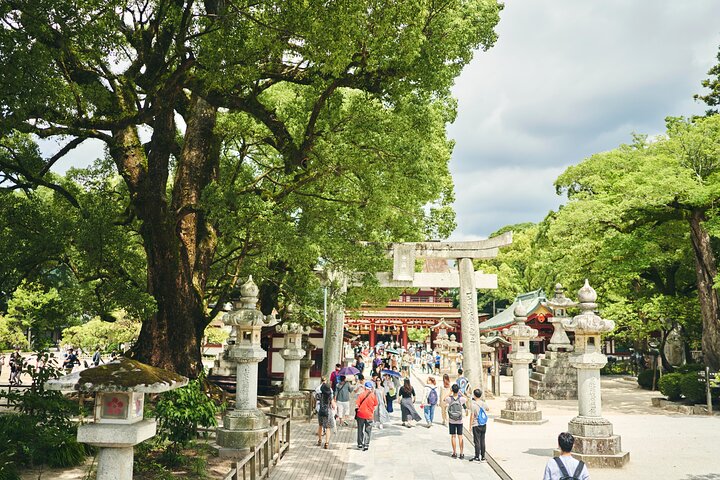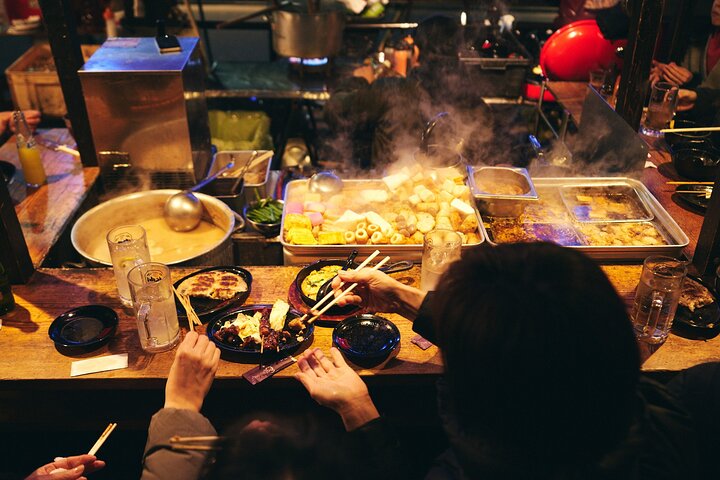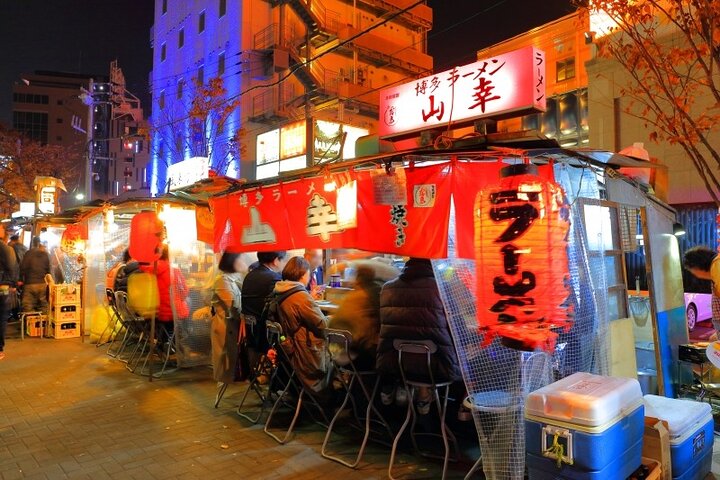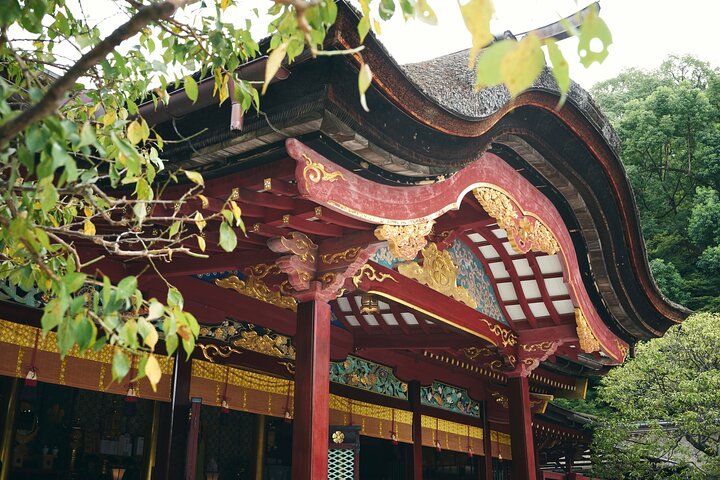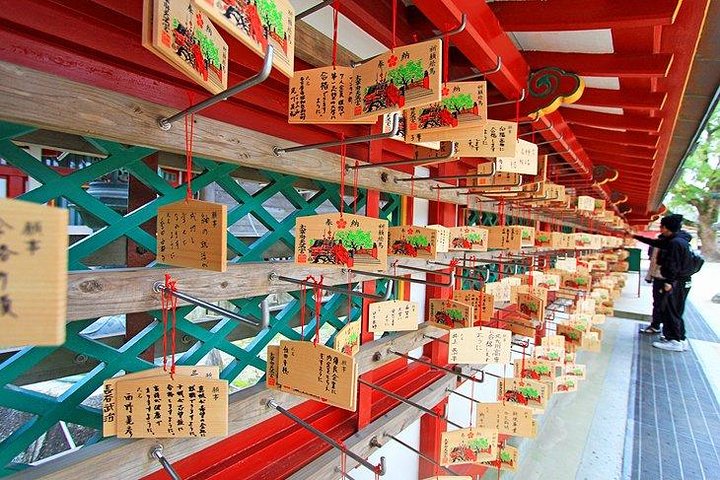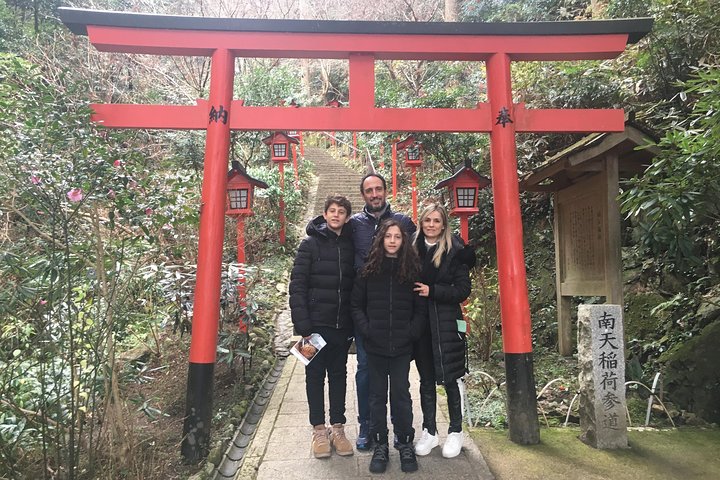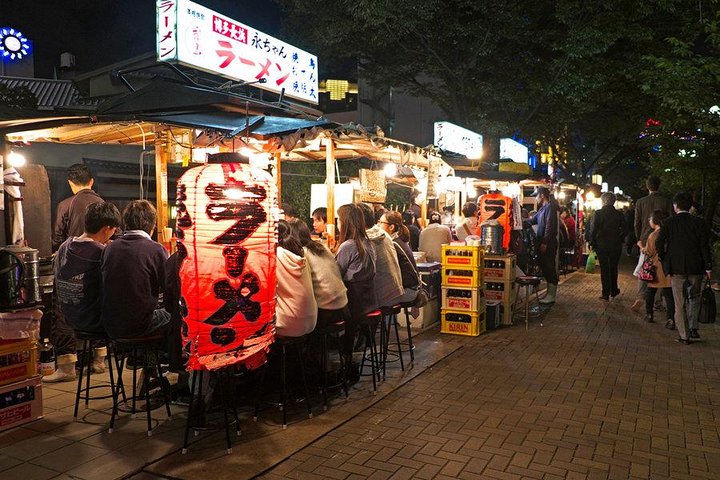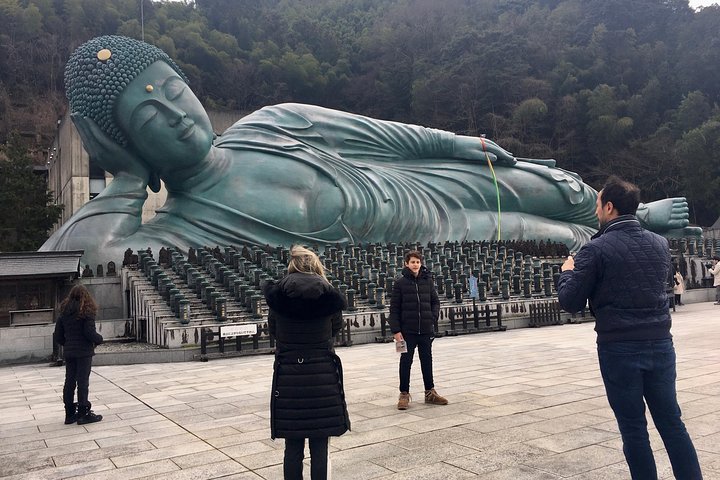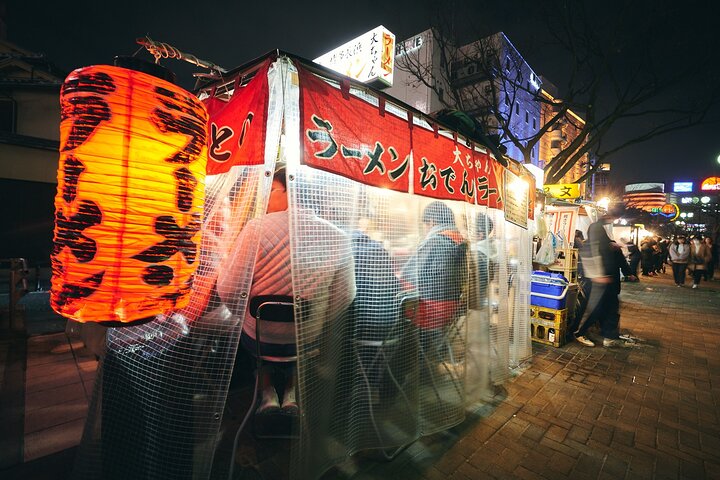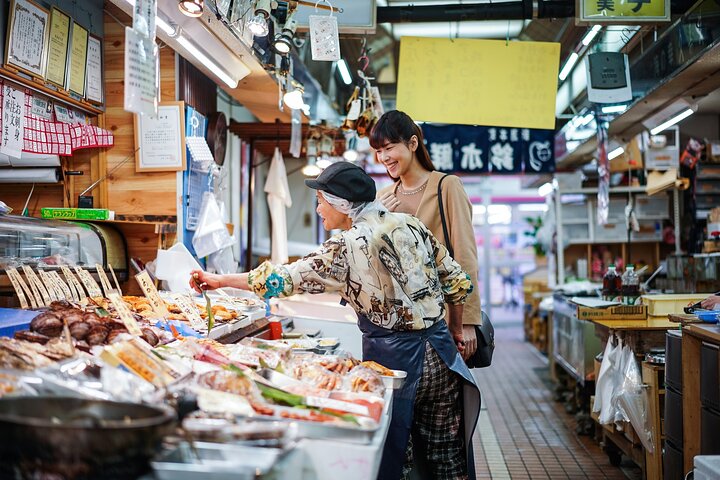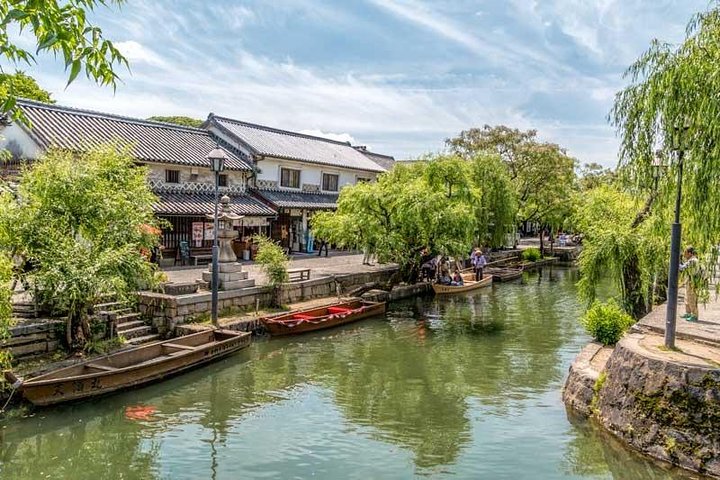Experience the best of Fukuoka on a full-day private tour with a licensed guide. Explore historical temples, indulge in unique food culture, and customize your itinerary to suit your interests!
Experience the best of Fukuoka on a full-day private tour with a licensed guide. Explore historical temples, indulge in unique food culture, and customize your itinerary to suit your interests!
- Fukuoka Castle Remains - Once a vibrant site during the Edo period (early 1600s), the castle now stands as remnants of stone walls, moats, and gates. However, the panoramic view of Fukuoka city from Fukusaki Hill is truly breathtaking. The Sakura Festival is the ideal time to visit and appreciate the full beauty of the castle ruins.
- **Sumiyoshi…
- Fukuoka Castle Remains - Once a vibrant site during the Edo period (early 1600s), the castle now stands as remnants of stone walls, moats, and gates. However, the panoramic view of Fukuoka city from Fukusaki Hill is truly breathtaking. The Sakura Festival is the ideal time to visit and appreciate the full beauty of the castle ruins.
- Sumiyoshi Shrine - As one of the oldest shrines on Kyushu, Sumiyoshi-jinja Shrine, like its Osaka counterpart, is dedicated to the protective deities of seafarers. It is the final shrine sailors would visit before embarking on their journeys. The Main Hall, rebuilt in 1623 in a classical style, is particularly impressive, along with numerous national treasures, including an ancient sword, a copper axe, and medieval manuscripts. The shrine, surrounded by a grove of Japanese cedars and camphor trees, offers splendid views over the River Naka. Be sure to explore the adjacent Sumiyoshi Park.
- Kyushu National Museum - Opened in 2005, Kyūshū National Museum (Kyūshū Kokuritsu Hakubutsukan) gained attention for its award-winning architecture and as Japan’s first new national museum in over a century. It houses a vast collection of art and historically significant artifacts related to the island’s rich history. Highlights include prehistoric relics from archaeological digs and exhibits tracing the island’s role as a trading link between Japan, China, and Korea.
- Kushida Shrine - Known as one of Japan’s most famous (and Fukuoka’s oldest) Shinto shrines, Kushida-jinja was established in AD 757. It features unique elements, such as intricate carvings of the Chinese zodiac and a gingko tree over 1,000 years old. The shrine is renowned for hosting the Hakata Gion Yamakasa each July, a spectacular two-week festival with prayers for health and prosperity, including a race with teams carrying heavy wooden floats around the city.
- Tochoji Temple - Tochoji Temple (南岳山 東長寺) is the head temple of the Shingon Buddhism Kyushu sect, known as Nangakuzan. It is dedicated to the famous monk Kobo-Daishi (Kukai 空海) and is one of the oldest temples in Japan established by Kobo-Daishi.
- Yatai - Fukuoka’s open-air food stands (屋台, Yatai) are perhaps the city’s most iconic symbol. Yatai typically seat seven or eight people, offering an atmospheric outdoor setting to enjoy simple, hearty foods. While there are many yatai scattered across Fukuoka, the best spot is the southern end of Nakasu Island, which features a long row of about 20 yatai attractively positioned along the water. Yatai usually open in the early evening.
- Uminonakamichi Seaside Park - Uminonakamichi Seaside Park (海の中道海浜公園, Uminonakamichi Kaihin Kōen) is a vast, family-friendly public park on a narrow peninsula across the bay from central Fukuoka. The park includes flower gardens, playgrounds, an amusement park with a Ferris wheel, sports fields, a water park, a zoo, and large open spaces perfect for picnics.
- Ohori Park - Ohori Park (大濠公園, Ōhori-kōen) is a delightful city park in central Fukuoka, featuring a large pond at its center. A walking path encircles the pond, just over two kilometers long, popular for jogging, walking pets, and leisurely strolls by the water. “Ohori” means moat in Japanese, and the pond was once part of the moat system of the neighboring Fukuoka Castle. Constructed between 1926 and 1929, the park was designed after the classical garden style of China’s West Lake. Three islands in the pond are connected by elegant stone bridges.
- Shofuku-ji Temple - Shofukuji (聖福寺, Shōfukuji) holds the distinction of being Japan’s first Zen temple. Founded in 1195 by the priest Eisai, who introduced the Rinzai sect of Zen Buddhism from China, the temple buildings cannot be entered, but visitors can stroll through Shofukuji’s attractive grounds and view the buildings from outside. Before Zen’s introduction, Buddhism had a long history in Japan dating back to the 500s. Zen’s teachings, which Eisai gathered during his travels in China, emphasized meditation and discipline as paths to enlightenment and became popular with the samurai class, which wielded political power through the shogunate government based in Kamakura.
- Momochi Seaside Park - Seaside Momochi (シーサイドももち, Shīsaido Momochi) is Fukuoka’s modern waterfront on reclaimed land along Hakata Bay. Originally developed for the 1989 Asia Pacific Expo, the area features wide, tree-lined streets, futuristic buildings, public parks, and no overhead phone or electricity lines.
- Canal City Hakata - Canal City Hakata (キャナルシティ博多) is a large shopping and entertainment complex, often described as a “city within the city.” It boasts around 250 shops, cafes, and restaurants, a theater, game center, cinemas, two hotels, and a canal running through the complex. Shoppers will find a variety of stores, from unique Japanese shops to international brands. The complex also offers a wide range of restaurants with reasonably priced menus, including the “Ramen Stadium” on the fifth floor, featuring eight ramen shops with noodle dishes from across Japan, including the local specialty, Hakata Ramen.
- Yusentei Park - Yusentei Park is renowned as the former residence of the 6th lord of Fukuoka, built in the 18th century. The park features a beautiful traditional-style garden and an ornate pond, offering a peaceful escape from the city’s hustle and bustle. Visitors can experience a glimpse of Fukuoka as it was in the past.
- Hakozaki-gu - Hakozaki Shrine is one of the most significant shrines in this region of Japan. The original shrine was destroyed by fire during the Mongolian invasion of Fukuoka in 1274 but was rebuilt and has stood in its current location ever since. Notable sights include a stone anchor used by Mongolian ships and a statue of Nichiren, a prominent Buddhist scholar in Fukuoka who predicted the Mongolian invasion.
- Fukuoka Tower - Fukuoka Tower is a must-visit for those wanting to see the city at its finest. The tower rises to approximately 234 meters, offering stunning views of the city below. The tower is beautifully illuminated at night and is a national symbol of the city, making it a worthwhile visit. Additionally, the tower features a restaurant at the top, where visitors can enjoy a meal while taking in the views.
- Nokonoshima Island - Fukuoka, known for its coastal location, boasts several picturesque islands just offshore. A relaxing 10-minute ferry ride offers stunning views across the water. Among the islands, Nokonoshima stands out with a radius of about 12 kilometers and a prime position in Hakata Bay. Visitors can enjoy activities like hiking and swimming, and even camp overnight to experience an evening under the stars.
- Atago Jinja Shrine - Atago Shrine, though less visited, is one of Fukuoka’s most beautiful shrines. Situated on a hillside, it offers sweeping views of the city and Hakata Bay, as well as the famous nesting storks. Visitors can admire the torii gate and ascend the stairs to the main shrine area. Although off the beaten path, the shrine is worth the effort for its views and insight into the city’s religious history.
- Dazaifu Temmangu - Dazaifu refers to the regional government of Japan’s past. At the Dazaifu Government Remains, visitors can explore the former governmental grounds. Nearby, a museum offers insights into Fukuoka’s history, making it a great destination for Japanese history enthusiasts.
- Yanagibashi Rengo Market - Known as the kitchen of Hakata, Yanagibashi Rengo Market features over 40 greengrocers and fishmongers selling fresh produce. The market also includes shops offering fruits, tofu, and cafes and bakeries with finger foods. Visitors can enjoy a delicious seafood Donburi, a Japanese rice bowl dish with fresh ingredients like squid and salmon sashimi.
- Nanzoin - Located 15 kilometers east of Fukuoka, Nanzoin Temple is one of the prefecture’s most visited and significant Buddhist shrines, attracting over a million pilgrims and visitors annually. The main attraction is the massive bronze statue of the Reclining Buddha, erected in 1995 and considered the largest bronze statue in the world. The pleasant walk to the site along a shady hillside trail from the quaint village of Sasaguri is marked by smaller Buddha statues, picturesque streams, bridges, and gardens. Also worth visiting is the famous wooden Buddha at Tōchō-ji, the oldest Shingon temple in Kyushu, founded in AD 806.
- Rakusuien - A Japanese-style garden and tea house where visitors can enjoy traditional Japanese Matcha (green tea) and sweets for just 500 yen. The entrance fee is 100 yen.

- Meet up with guide on foot within designated area of Fukuoka
- Licensed Local English Speaking Guide
- Customizable Tour of your choice of 3-4 sites from ‘What to expect’ list
- Meet up with guide on foot within designated area of Fukuoka
- Licensed Local English Speaking Guide
- Customizable Tour of your choice of 3-4 sites from ‘What to expect’ list
- Transportation fees, Entrance fees, Lunch, and Other personal expenses
- Private Vehicle
- You cannot combine multiple tour groups.
- Guide Entry fees are only covered for sights listed under What to Expect.
- Transportation fees, Entrance fees, Lunch, and Other personal expenses
- Private Vehicle
- You cannot combine multiple tour groups.
- Guide Entry fees are only covered for sights listed under What to Expect.
This value-packed trip with a government-licensed and experienced English Speaking tour guide is a fantastic and efficient way to explore Fukuoka!
Enjoy a full-day walking tour with your private guide, as he/she introduce modern and traditional aspects of this dynamic, ancient city! This dynamic city is home to many historical temples and is famous for…
This value-packed trip with a government-licensed and experienced English Speaking tour guide is a fantastic and efficient way to explore Fukuoka!
Enjoy a full-day walking tour with your private guide, as he/she introduce modern and traditional aspects of this dynamic, ancient city! This dynamic city is home to many historical temples and is famous for its unique food culture.
Your guide will pick you up at your hotel or any other point at your convenience to start your day. You will then have the choice of visiting any of Fukuoka’s famous sites.
Let us know what you would like to experience, and your guide will then arrange a six-hour tour that’s best for you!
Note*1: Please select your must-see spots from a list in the tour information to create your customized itinerary.
- This is a walking tour. Pick up is on foot.
For a full refund, cancel at least 24 hours before the scheduled departure time.
For a full refund, cancel at least 24 hours before the scheduled departure time.
